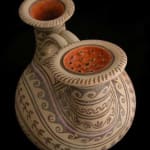Daunian Double-Spouted Askos, 500 BCE - 400 CE
Terracotta
6.25 x 7.25
PF.5922
Further images
In the eighth century B.C., Greek settlers left their homeland behind and established a string of colonies along the Adriatic coast of Southern Italy. After the rise of Rome centuries...
In the eighth century B.C., Greek settlers left their homeland behind and established a string of colonies along the Adriatic coast of Southern Italy. After the rise of Rome centuries later, this region would become known by the Latin term Magna Graecia, literally “Greater Greece,” due to the dense concentration of Greek settlements. The Greeks flourished here alongside the native populations, amassing great wealth through trade and importing their Hellenic culture throughout the area. They in turn were influenced by their neighbors, so that Magna Graecian pottery developed into a unique style that reflected both Greek and native Italian traditions. The Daunians were one such native culture that lived alongside the Greek colonies. Daunian pottery can be characterized by its rounded forms, geometric, linear designs, and eathern tones. The Greeks adopted some of the Daunian forms for themselves, revealing the cultural interplay that so distinguishes the art of Magna Graecia, both in respects to the Greeks as well as the native peoples such as the Daunians.
This double spouted askos, which originally served as an oil flask, was one of the types of Daunian ware that would influence their Greek colonist neighbors. Rendered in a typically ornate Daunian fashion, this vessel is covered in abstract motifs painted in brown and further highlighted with pink and orange touches. The bulbous body of the askos has been segmented into curving bands that conform to the shape of the vessel. The motifs that fill the band seem to be based on natural themes, one can identify a spiraling wave pattern as well as a bird in flight. The top of the body, directly under the handle connecting the two spouts, is the depiction of two clearly identifiable leaves. Perhaps this touch of foliage alludes to the plants that were necessary for the manufacture of the oils or other liquids that were once contained within. The Daunians love of decoration and ornamentation is fully revealed by the fact that even the circular flat bottom of this askos is embellished with radiating lines. Overall, this gorgeous vessel, which comes down to us in near perfect condition, appears as vibrant and fanciful as the day it was fired. Looking inside, we almost expect there to be some oil still left over.
This double spouted askos, which originally served as an oil flask, was one of the types of Daunian ware that would influence their Greek colonist neighbors. Rendered in a typically ornate Daunian fashion, this vessel is covered in abstract motifs painted in brown and further highlighted with pink and orange touches. The bulbous body of the askos has been segmented into curving bands that conform to the shape of the vessel. The motifs that fill the band seem to be based on natural themes, one can identify a spiraling wave pattern as well as a bird in flight. The top of the body, directly under the handle connecting the two spouts, is the depiction of two clearly identifiable leaves. Perhaps this touch of foliage alludes to the plants that were necessary for the manufacture of the oils or other liquids that were once contained within. The Daunians love of decoration and ornamentation is fully revealed by the fact that even the circular flat bottom of this askos is embellished with radiating lines. Overall, this gorgeous vessel, which comes down to us in near perfect condition, appears as vibrant and fanciful as the day it was fired. Looking inside, we almost expect there to be some oil still left over.











